Published on: 05 Sep, 2025
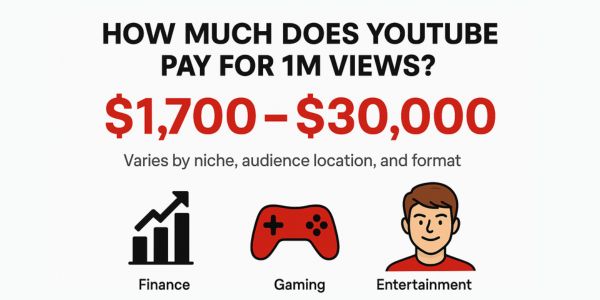
Are you a new creator and are wondering how much does YouTube pay for 1 million views?
When you get 1 million views on Youtube the pay is between $1,700 and $30,000 but the difference lies in your niche, audience’s location, and content format.
The channels that focus on finance or tech often sit at the higher end of the scale. And if we talk about entertainment and gaming channels, then they usually earn a bit less unless they get boosted by sponsorships or merch sales.
Here’s a quick look at earnings by niche in 2025:
|
Niche |
Estimated Earnings (per 1M views) |
|
Gaming |
$1,000 – $4,000 |
|
Finance |
$15,000 – $30,000 |
|
Entertainment |
$1,000 – $30,000 |
But how does this money really come in? Let’s discuss that in this blog.
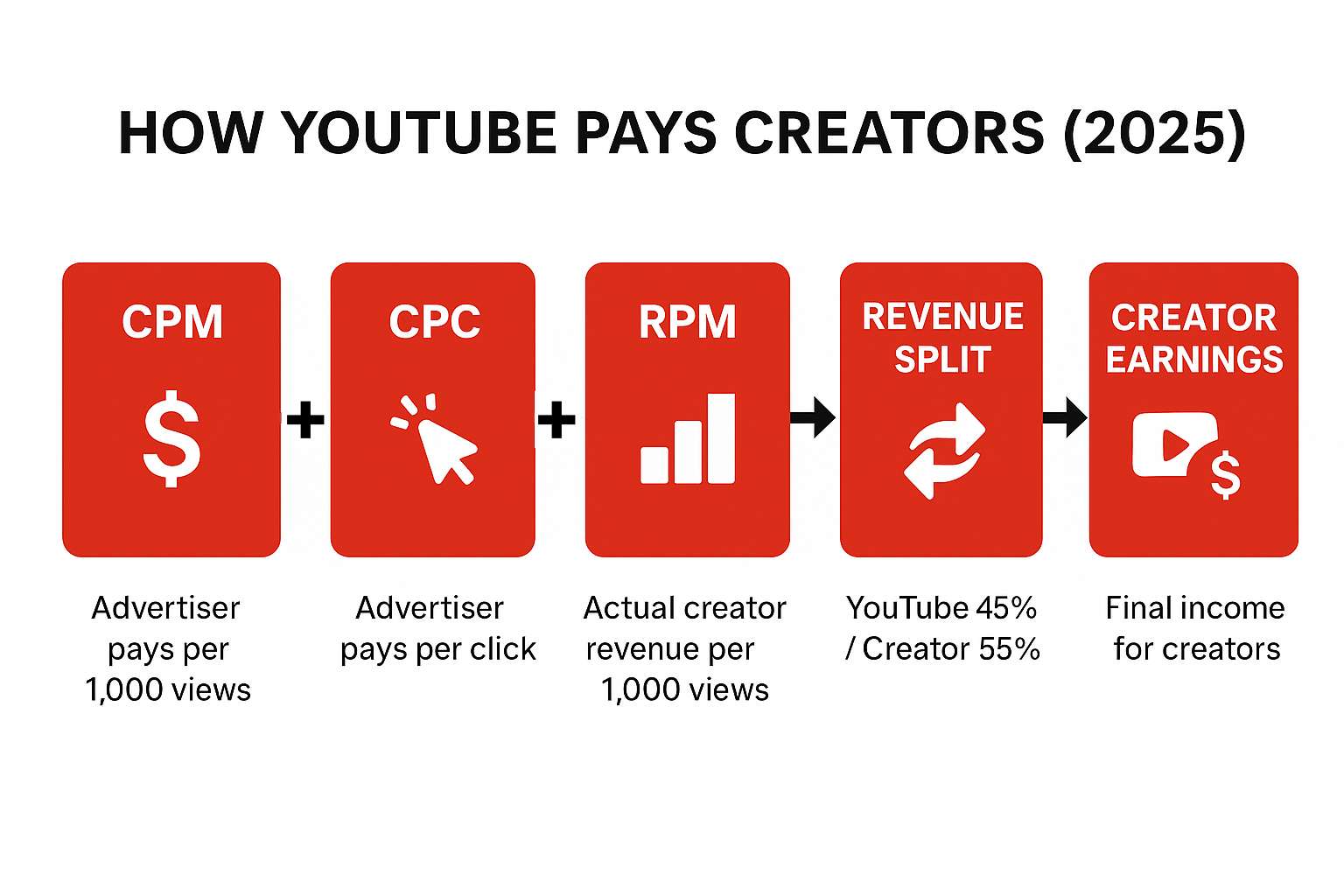
The answer to how youtube pays creators is based on four factors that are mentioned below:
This is the amount that the advertisers pay for 1,000 ad views which can be different for each category like, it can range from $1 in entertainment and $30+ in finance.
This is the cost that advertisers pay every time a user clicks on their ads. The finance, tech, and education category thrive here.
This is the actual earnings for every 1,000 views or impressions that the creators get.
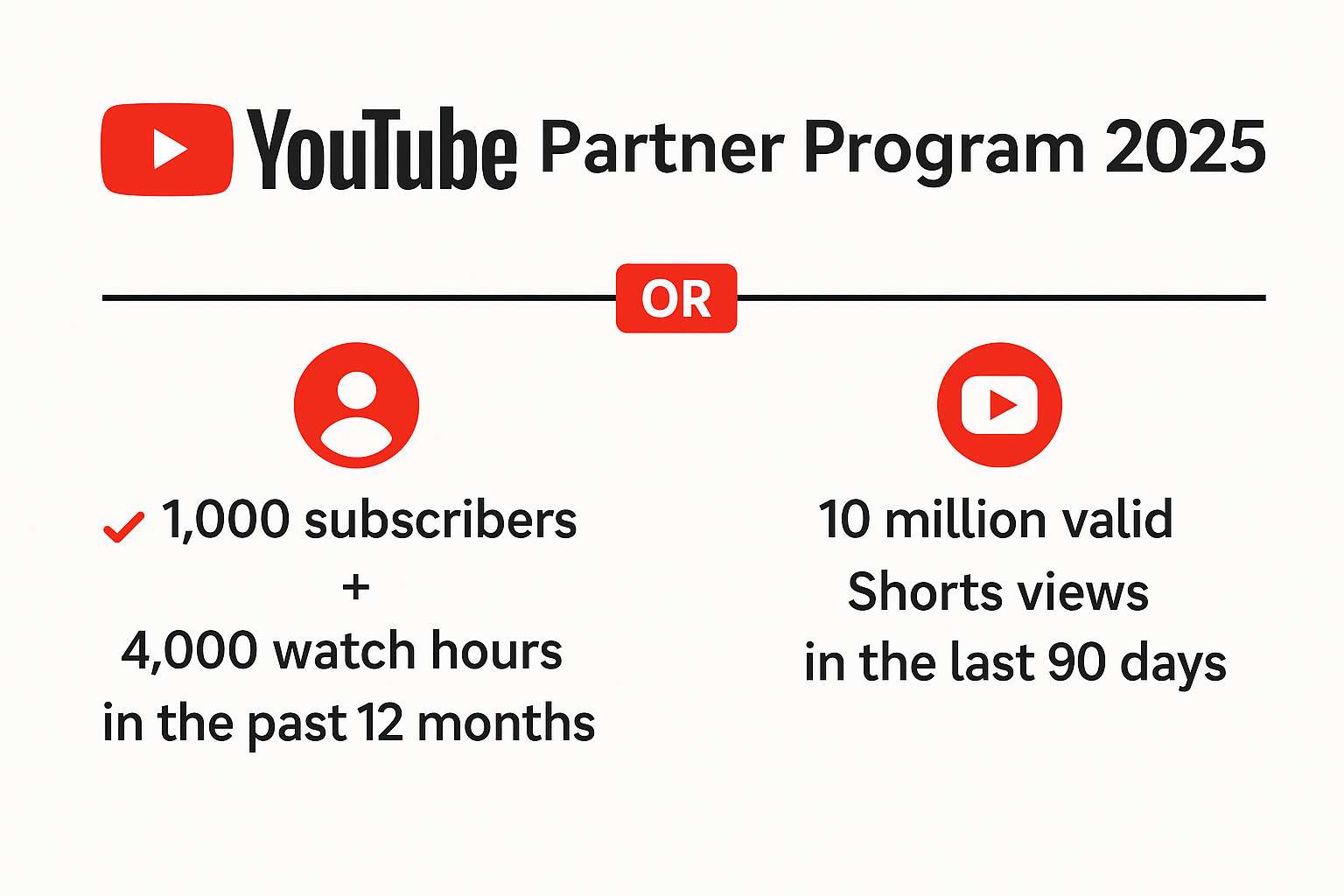
To be eligible for the Youtube Partner Program in 2025, you need a few requirements.
You should either have 1,000 subscribers + 4,000 watch hours in the past 12 months/span>
OR
10 million valid Shorts views in the last 90 days.
The total revenue by your video is split in two parts where YouTube keeps 45% and the creators get 55%.
One thing you should know is, ad blockers can hurt your total earnings since the skipped or blocked ads get zero revenue amount.
The Youtube premium also adds to a creator’s income which is based on the watch time from Premium users.
So, If your channel has 1M views, you can make up to $2,000, while the other channel might earn $25,000+ with Youtube Premium.
Youtube generally pays creators anywhere between $1,700 and $30,000 and not all views are created equal. Depending on your niche, the amount varies and you get paid more or less than other creators. Here’s why niche matters.
|
NICHE |
ESTIMATED EARNINGS (per 1M views) |
|
Gaming |
$1,000 – $4,000 |
|
Finance |
$15,000 – $30,000 |
|
Tech |
$4,000 – $10,000 |
|
Education |
$5,000 – $15,000 |
|
Fitness |
$2,000 – $8,000 |
|
Music and Entertainment |
$1,000 – $30,000 |
In this niche, you get paid anywhere between $1k to $4k which is fun but has low-paying ads and that is the main reason why gaming channels rely heavily on sponsorships.
These channels are paid between $15k to $30k. The banks, fintech, and stock apps bid higher and they are some of the highest CPMs that are available online.
In the Tech niche, you get around $4k to $10k and the product reviews and tutorials are what attract your actual audience and valuable advertisers.
The payout is between $5k to $15k in the education niche. The tutorials and courses get a stable or mid–high CPMs which is still good.
In this niche, the earning is around $2k to $8k which is popular but seasonal and the supplement brands spend the most money on ads
The music industry has a huge pay variance, which starts from $1k and can go up to $30k. The music labels earn more from ads and royalties.
The audience’s location matters and it can massively impact your CPM rates. It’s your audience’s location that sets your CPM, not where you are from or uploading from. A creator in India that is earning from US viewers will still get US-level CPMs. This is the main reason why 1 million views in the US could be almost 10 times more than in India.
The advertisers in the US, UK, Canada, and Germany pay far more than those located in India, Southeast Asia, or Latin America.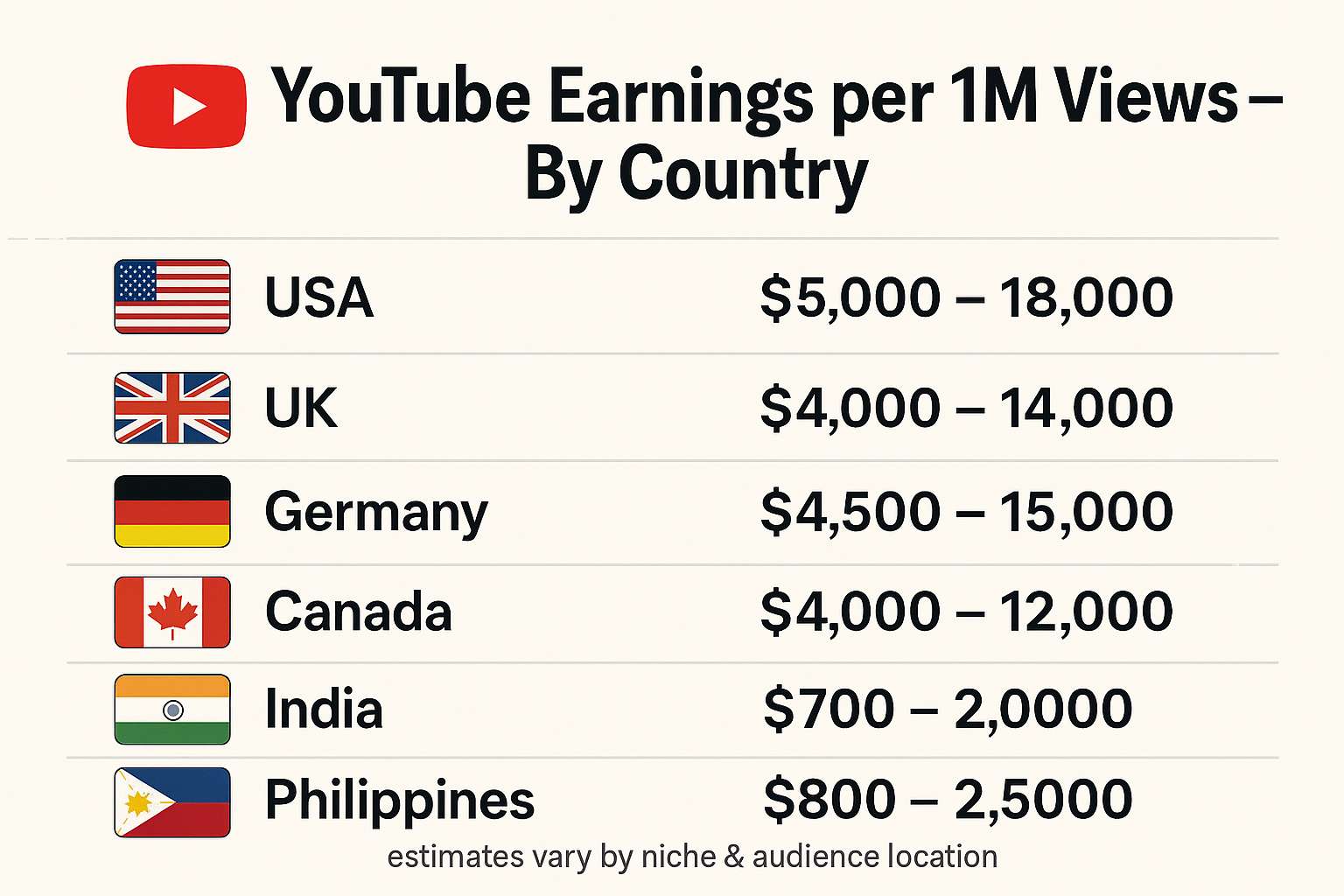
Here’s a quick look at the Youtube earnings by country:
|
COUNTRY |
AVERAGE PAY (per 1M views) |
|
USA |
$5,000 – $18,000 |
|
UK |
$4,000 – $14,000 |
|
Germany |
$4,500 – $15,000 |
|
India |
$700 – $2,000 |
|
Philippines |
$800 – $2,500 |
|
Canada |
$4,000 – $12,000 |
The advertisers spend more where the buying power is higher and that’s why creators from all over the globe try to target audiences in the Tier-1 countries.
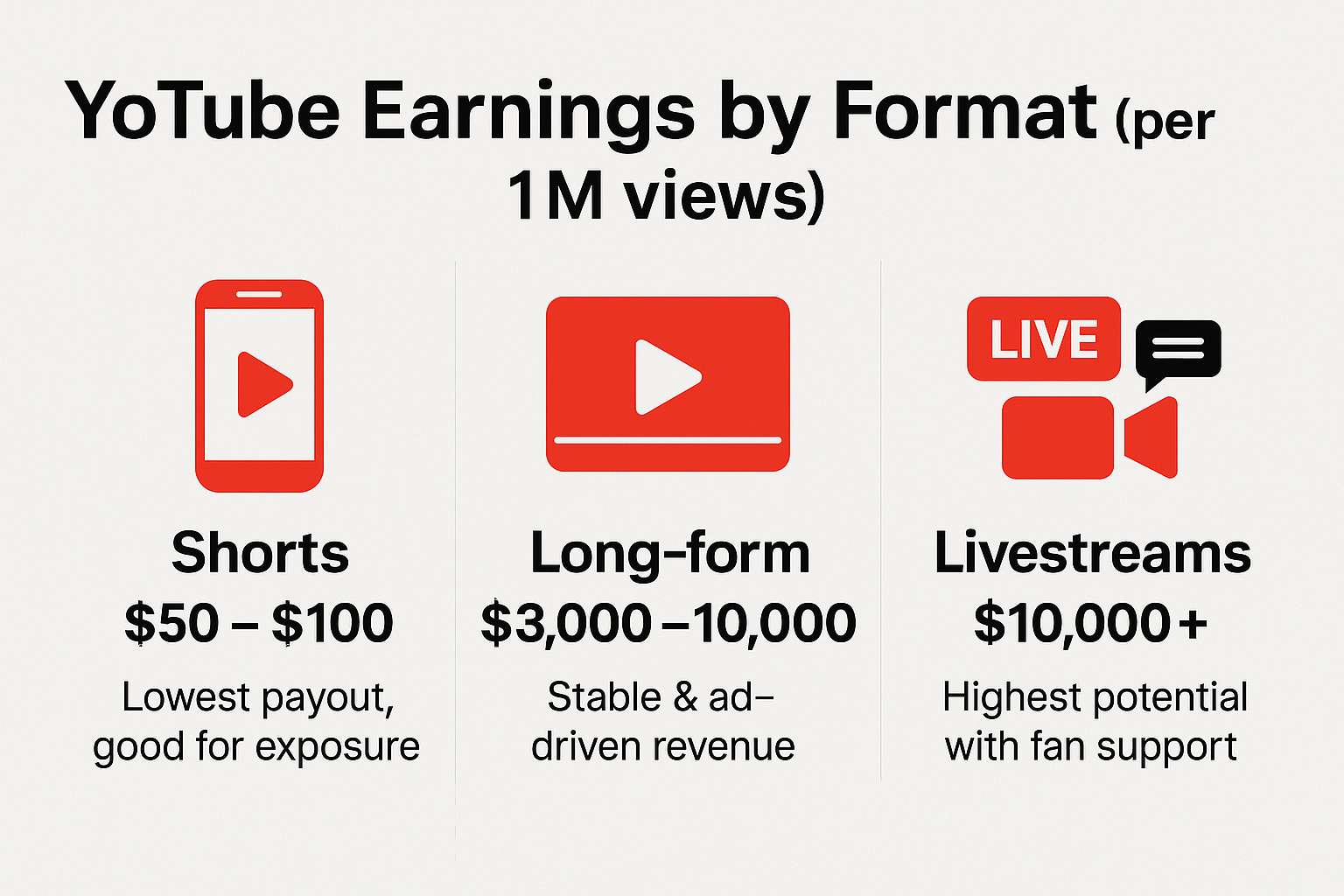
As a creator, you should know that not all YouTube views are worth the same, and the format you choose can really make a difference in how much you earn. In 2025, creators have three main ways that they can publish their content on youtube, they are shorts, long-form videos, and livestreams and each of these have a different pay scale.
They are the easiest way to get viral reach, but they don’t pay that well. For 1 million views on Shorts, you only get $50 to $100. This is because Shorts ads are limited and the RPM comes from a shared revenue pool of many creators, which makes it very different from long-form CPM earnings. And while they do help you build an audience, you don’t get paid much.
The 8+ minute videos remain the most reliable option to get monetized on Youtube. For 1 million views with ad breaks and higher watch time you can earn anywhere from $3,000 to $10,000, depending on your niche.
They can be the most profitable format of all because the income doesn’t just come from ads but also super Chats, stickers, memberships, and sponsorships. If your livestream has 1 million views, the creator can easily cross $10,000+ and get even more if the engagement is very strong.
|
FORMAT |
AVERAGE EARNINGS (per 1M views) |
|
Shorts |
$50 – $100 |
|
Long-form |
$3,000 – $10,000 |
|
Livestreams |
$10,000+ (ads + fan support) |
To say that in simple words, shorts help grow your channel, long-form videos get you to monetize on the platform and pay you based on views and livestreams build a deep fan support and can get you to earn more.
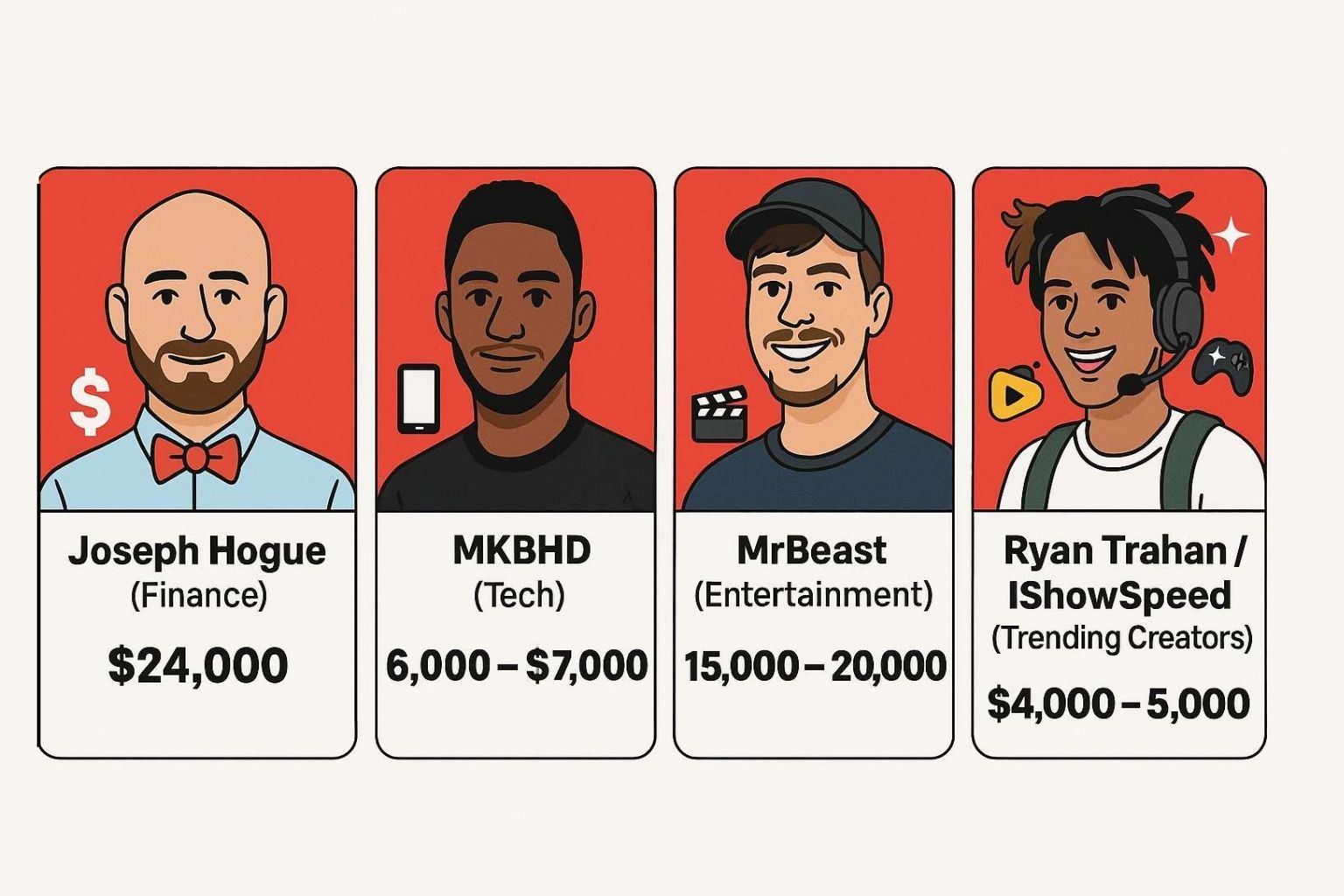
Now, you have understood how much each format of content pays you, now let's see some real life YouTuber earnings case study.
Joseph Hogue is a finance niche YouTuber behind the channel Let’s Talk Money, and he has openly shared his earnings from ad revenue. Joseph Hogue YouTube income is around $24K for 1 million views because it attracts some of the highest CPMs on YouTube. He once shared that his RPM crossed $24 per 1k views, which for any creator is huge.
Banks, fintech companies, and investment apps buy ad space on such videos aggressively which drives up the RPM. And, unlike other niches, these finance videos benefit from long watch times and advertiser trust. This shows how finance is one of the most profitable niches for creators.
Marques Brownlee who is also known as MKBHD, is one of the biggest tech reviewers on YouTube. His sleek, long-form videos in which he reviews the latest smartphones, EVs, and gadgets bring him to an estimated $6,000 to $7,000 per 1M views.
And it might not be as high as finance but his RPM is still solid because tech brands also spend a huge amount on advertising. He also earns a good amount from sponsorships and affiliation, but his ad revenue shows how the Tech niche with global reach can deliver you stable and profitable for creators.
MrBeast is one of the more famous youtuber in the entertainment industry and he is often seen in YouTuber earning case studies. His entertainment videos get millions of views within hours, and his ad revenue usually goes up to an average of $15,000 to $20,000 per 1M views.
This number may seem high for entertainment, but his long-form content has massive watch times and a US-based audience that he focuses on, drives up his CPMs. This scale does not include sponsorships and merchandise sales, which plays a major role in the building of his own community. He has said in interviews that his ad revenue is a small fraction as compared to merch and sponsors. MrBeast’s case shows how high reach and large audience loyalty can really bring in huge profits.
The latest trending creators like Ryan Trahan and IShowSpeed highlight can show you how earnings can vary widely. Ryan Trahan is known for his storytelling challenges and he makes around $4k to $6k per 1M views where he is targeting younger US audiences.
And if we see the revenue of IShowSpeed who streams live gaming and entertainment, you can see that his earnings are more from Superchats and donations, where he sometimes makes tens of thousands during a single event. His ad revenue may be closer to $2k–$5k for 1M views but it can be more. Both of these cases together show how niche, format, and audience location can actually impact your profit and earnings.
Are you curious about how YouTubers make money beyond just ads? The ad revenue gets you the spotlight, it's true but the most successful creators earn more from other YouTube income sources too. Here are some of the main ones:
Brands pay creators directly to feature their products or services in their videos and depending on their niche and audience, a single brand deal can be worth hundreds to tens of thousands of dollars. And with brand deals on YouTube, you can actually get profits.
Many YouTubers use affiliate links to recommend the products that they are using in the video and so when viewers are looking through those links, the creator earns a commission. This is especially popular in niches like tech, fitness, and lifestyle.
Selling their own merchandise like T-shirts, mugs, or digital products can give creators another source of revenue. Also, getting Youtube memberships also helps the creator when the subscriber/members pay monthly to get exclusive badges, emojis, and extra perks.
Some of the creators prefer 3rd party platforms like Patreon, where fans can subscribe for exclusive content, early access, or behind-the-scenes looks which can also be a steady source of income.
During livestreams, fans can pay to make their messages stand out or send you stickers that are displayed on the chat or screen. This really adds up a good amount, especially for creators who have an audience that highly engages with their content.
New creators should know that relying solely on ads is not the way to go. They can make a proper income through these methods as well along with their fans' support.
At BuyLikesServices, we help creators, influencers, and brands to grow with real engagement-no bots, no fakes, just pure results. We help fuel your growth with real followers, authentic engagement, and social proof that stands out from the crowd. Get noticed, get followers, and get famous!
2 million views on Youtube is worth around $3,400 and $60,000, depending on your particular niche, audience, and country.
It is usually between $150 to $3,000. The finance and tech niches make the most amount and the education and entertainment makes just the average amount.
Yes, Shorts RPM is 10 to 50 times lower than long form videos and they are better for exposure but not if you want to earn from just that.
No, Subscribers count does not generate money directly because they only help by boosting your reach and overall engagement.
If your video goes viral, then it can hit 1M views in hours but for most channels, it can take around months or even years.
Yes, If ads are skipped or blocked, then the creators earn nothing from those views.
Yes, longer videos can earn more revenue because that adds to it more ad slots.
RPM is better for measuring actual earnings, while CPM is just the advertiser cost.
2 - 3 ads for a 10-minute video is generally fine for balance and viewer retention.
So, is YouTube a stable income source? The honest answer to this is no. After reviewing so many youtube channels, we can say that just the videos are not enough to be a big creator on Youtube because if one creator is making around $1,500 for a million views, another one might be getting $25,000 for the same amount of views. The main difference depends on niche, location, and video format too.
To actually make a living from YouTube, as a new creator you need more than ad revenue. The smart creators build multiple income sources like sponsorships, affiliate marketing, merch and memberships that gets fan support faster and helps build their own community. This helps you even if the ad revenue drops, so that your income stays steady.
So, a final advice would be, you can make a living with Youtube but only if you treat it as a business, know how to diversify and expand your sources of earnings and focus more on long-term growth instead of relying on views alone.

About the Author Johnson
Johnson is the foremost authority on YouTube and Facebook marketing. On Buylikesservices, she shares insights collected during her experiences managing promotional campaigns for brands and creators, using YouTube and Facebook marketing tools, and planning advertising for those platforms.
Connect on LinkedInHow Much Money Does YouTube Pay For 1 Million Views (2025)
05 Sep, 2025
Share article via: